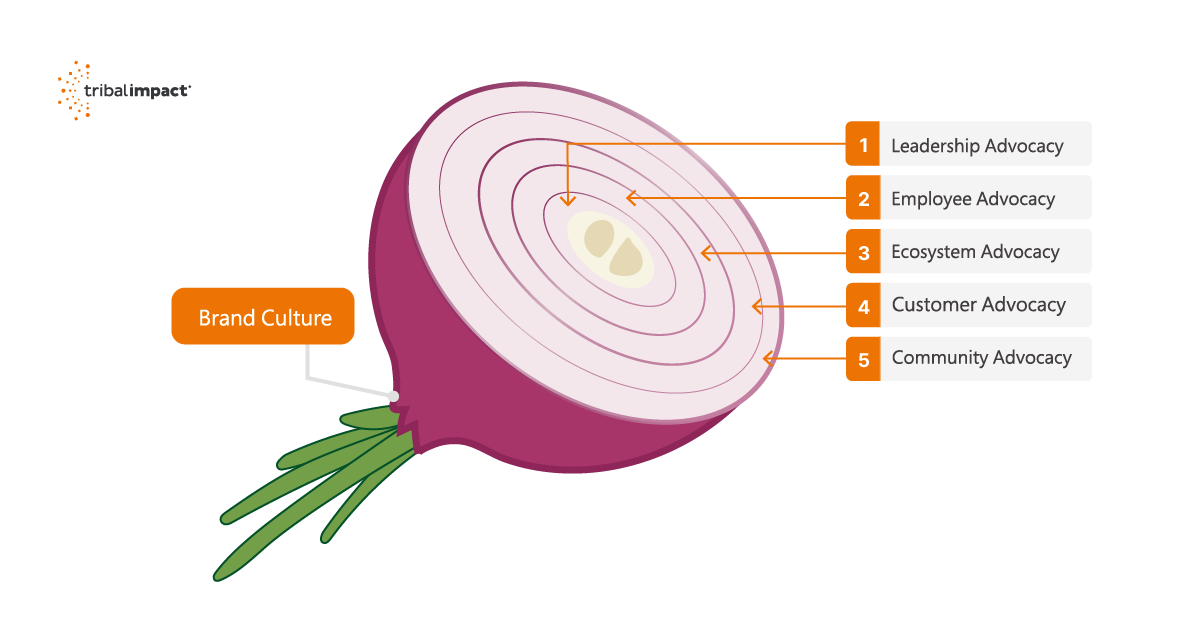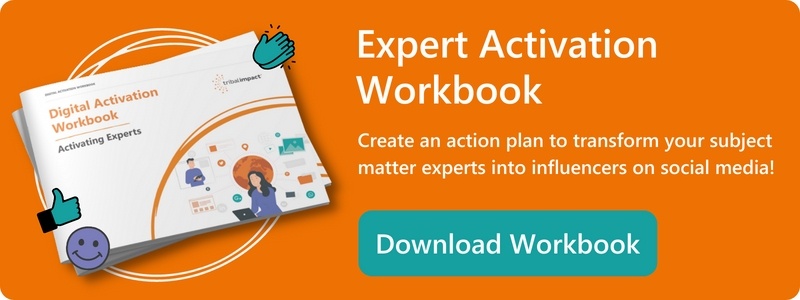My daughter can eat a red onion like an apple. No jokes. It makes my eyes water just thinking about it, but a little advocacy inspiration came to me the other day while watching her devour another onion.
Layers.
You see, when it comes to employee advocacy, there are more layers to it than just getting employees to share company content on their social networks.
Like an onion, when you peel those layers back, you realise that the closer you are to the root, the stronger and more intense your relationship is with the culture and brand (or at least it should be).
Let me explain the five layers of employee advocacy, starting with the root.

Root: Brand Culture - The Heart of Employee Advocacy
One of my very first jobs involved working in a restaurant kitchen, where I learned how to cook and cut onions without crying. The trick is to keep the root intact when cutting. When you cut the root, you release a chemical irritant that stimulates the eyes’ lachrymal glands, and they release tears.
At the root of our advocacy onion is culture. It’s what the employer brand is centred around, why your employees are attracted to work for you, and why they stay.
This culture is the embodiment of the brand, the company's values, its purpose, its vision, and its mission. It's the magnetic force that draws employees in and increases employee engagement.
Without a strong and authentic brand culture, no employee advocacy program can truly succeed.
In employee engagement strategies, the brand culture acts as the root. It's the narrative that employees share, the stories they tell, and the experiences they relay.
When employees genuinely connect with the brand culture, they become natural employee advocates, sharing content that resonates with their personal and professional networks.
This organic reach, stemming from a deep-rooted brand culture, amplifies the company's message in ways traditional marketing can't achieve.
It's the foundation upon which all other layers of advocacy are built, making it the most crucial layer to nurture and strengthen.
Layer 1: Leadership - Pioneering Employee Advocacy Programs
You would hope senior leaders would be focused on embodying the brand's values and setting the stage for a thriving employee advocacy program, as they are the ones closest to the root. They are closest to the vision, mission, and purpose, leading and inspiring employees around it.
Leaders play a pivotal role in shaping the brand culture and ensuring it resonates throughout the organisation. And this is why activating your leaders in advocacy serves so many different purposes.
A leader shouldn't just live and breathe the company’s mission, purpose, and vision. They should be demonstrating the brand values. With 68% of employees preferring to work for leaders who use social media, it helps attract new talent whilst also improving employee retention. (Source: Brunswisk).
Engaging your leaders will play a huge role in building a successful employee advocacy program. You don't have a company without people, so leaders are the next layer of our onion.
They have to communicate what your brand is about, and I'm not talking about them just being an extension of the brand voice. Leaders need to humanise that voice and how to live by brand values, not just talk about them.
I believe a common mistake companies make is using leaders as an extension of the brand voice rather than showing their human side and living the brand voice.
It's all about storytelling, and that starts with leaders.
Layer 2: Employees - An Employee-Centric Approach
The next integral layer in the advocacy onion is the employees. Employee advocacy is a term that’s been buzzing around, but there’s a common misconception that needs addressing.
Companies often misstep by viewing employees merely as a channel for distributing content. However, this perspective is not just limiting; it’s a missed opportunity to deepen the roots of brand culture.
Employees are not just message carriers but brand amplifiers with unique voices and perspectives. Empowering them goes beyond giving them the tools to share content on platforms like LinkedIn. It’s about helping them understand their unique place and voice within the company, connecting their personal ‘why’ to the organisational brand.
This shift from a brand-centric to an employee-centric approach transforms employees into storytellers, experts, and authentic brand advocates.
Layer 3: Partner Ecosystem - Extending the Benefits
In many organisations, particularly within the IT sector, the concept of a partner ecosystem is integral. These partners range from resellers to value-added resellers and strategic partners.
This isn’t just a network but a symbiotic relationship where channel partners become an extension of the brand, amplifying its reach and influence.
The advocacy doesn’t stop with internal stakeholders; it extends to these partners. Smart organisations like SAP and IBM are pioneers in this realm. They are looking at how they bring that channel ecosystem into their advocacy programs.
It’s not a passive inclusion but an active engagement, where partners are equipped with tools like Sales Navigator licences and, more importantly, empowered with tailored training to amplify their advocacy roles.
SAP actively encourages the creation of diverse content, from blogs to videos, harnessing the expertise within their partner ecosystem. This content is integrated into SAP’s advocacy tools, making it accessible to the broader SAP employee community.
This approach is transformative. Many partners may not have the extensive reach or brand recognition that SAP boasts, but within this advocacy framework, the SAP community becomes a spotlight, shining a light on the expertise and insights of partners.
That's just next-level advocacy, and I just love that!
Layer 4: Customers - The Unsung Heroes of Advocacy
Then, there are the customers. Many companies, especially IT companies, have initiated customer advocacy and referral programs.
There is a tool called Influitive, which is particularly good at this. Influitive mainly focuses on customer advocacy and referral programs. Cisco stands out as a prime example in this context. They realised that their customers were their best advocates.
Cisco didn’t just acknowledge this fact; they acted on it. They trained their customers as part of their customer advocacy program, equipping them with the social skills needed to create content, become ambassadors, and share their stories.
This approach mirrors how they engage their employees, leaders, and partners in advocacy. Cisco went beyond the conventional – they didn’t just ask customers to step into a studio, record a video, and share it. That would have been the quicker route.
Instead, Cisco invested in the long-term development of their customers. They provided them with the skills to enhance their professional brand, increase their visibility, and bolster their credibility as practitioners. This wasn’t just about Cisco; it was about enabling customers to talk about the significant work they accomplished in collaboration with Cisco.
Customer advocacy isn’t confined to writing a reference paper, a case study, or recording testimonials. It’s about elevating the customers’ expert presence and eminence on social platforms.
Layer 5: Community - Harness Their Passion for the Brand
Beyond customers, there’s another layer – the community. This group includes alumni and others who, while not current customers, employees, or partners, still have a strong affinity for the brand.
They are the fan followers, the individuals who, though they don’t buy, sell, or work for the company, are ardent supporters. They engage with the content and are passionate about everything the brand represents.
This community is integral to the brand’s ecosystem. Empowering every layer, from the root to the outermost, amplifies the brand’s efficacy. It’s a holistic approach, not limited to a single layer, making the advocacy profoundly powerful and resonant.
Getting Your Layers in Order
So there's your onion! There’s no strict order to these layers but a logical progression. Activating leaders inspires employees, and employee efforts naturally cascade to partners and customers.
I've seen it done with customers first, but bringing in customers before employees are fully onboarded feels a bit backwards. Your employees are the bridge to channel partners, so it makes sense to empower them first.
Think of it as an advocacy network. Every layer, from leaders to the community, is interconnected. Prioritise where to start, and remember, it’s all connected.
Activating one layer naturally extends to the next. Equip each layer with the needed skills and knowledge, and you have a robust, resonating advocacy network.

